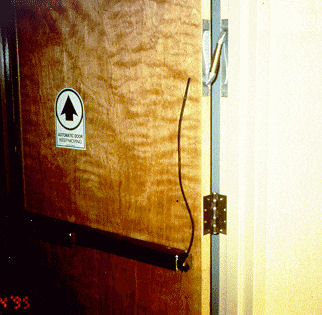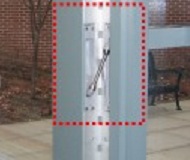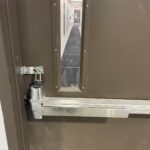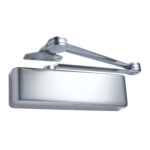 An EPT is an electrical power transfer, which is used to transfer wires from the door frame to the edge of the door. It is used when there is a door-mounted piece of electrified hardware which requires power and/or sends a signal to a remote location. The security consultants that I have worked with all prefer the EPT over electric hinges or door loops, which perform the same function. It is also preferred over an electric hinge by most installers, because the EPT can be installed when the wiring connections are made, rather than being installed by the carpenter, removed for wiring, and reinstalled, getting mangled in the process. The EPT is concealed when the door is closed (the door loop is exposed and prone to abuse) and it can accommodate larger gauge wires than an electric hinge.
An EPT is an electrical power transfer, which is used to transfer wires from the door frame to the edge of the door. It is used when there is a door-mounted piece of electrified hardware which requires power and/or sends a signal to a remote location. The security consultants that I have worked with all prefer the EPT over electric hinges or door loops, which perform the same function. It is also preferred over an electric hinge by most installers, because the EPT can be installed when the wiring connections are made, rather than being installed by the carpenter, removed for wiring, and reinstalled, getting mangled in the process. The EPT is concealed when the door is closed (the door loop is exposed and prone to abuse) and it can accommodate larger gauge wires than an electric hinge.
Von Duprin offers 2 different EPT’s, and it’s important to know which one to use when.
The EPT-2 has two 18-gauge wires (up to 2 amps at 24vdc with a 16-amp maximum surge) and is typically used with a Von Duprin electric latch retraction (EL) device.
The EPT-10 has ten 24-gauge wires (up to 1 amp at 24vdc with a 16-amp maximum surge) and is typically used when more than 2 wires are needed, for example, with a Chexit delayed egress device, or an electrified exit device or lockset with an RX or LX switch. Some security consultants prefer to use the EPT-10 even if only 2 wires are required, so they can “double-up” or have extra wires for future needs.
Keep in mind that an EPT can’t be used with swing clear hinges or invisible hinges, and can be difficult to prep for in existing doors and frames. If continuous hinges are used with an EPT, the hinge leaves must be prepared for the EPT as well as the door and frame.
I just ran across another of my favorite “Doors Gone Wrong” photos (right). The door and frame were prepped for the EPT, but the wire was run down the face of the door to the EL device! OOPS!
You need to login or register to bookmark/favorite this content.






We’ve always specified power transfers when we’re calling for electrified hardware. On every job it seems that the request is made by the contractor to switch to electric hinges. When there’s not a reason the power transfer is specifically required, we allow the change. I haven’t looked into the cost, but I’m guessing using an electric hinge is the more economical method? Can you weigh in on the cost comparison for an installation in a standard hollow metal door and frame with an electrified lockset? Aside from the couple restrictions listed in the post, are there any other instances when using an electrified hinge is clearly the better choice over a power transfer?
Hey, nice website. I came across this on Google, and I am stoked that I did. I will definitely be coming back here more regularly. Wish I could add to the post and bring a bit more to the table, but am just taking in as much info as I can at the moment.
Thanks Armil! I hope you find the information helpful. Let me know if there’s something you think I should cover.
– Lori
Has anyone ever seen a chart on locating EPT’s. I always have to do a lot of match to Order Doors and Frames?
Paul did you ever find anything?
when is an enclosed backbox required by code for an EPT?
The EPT comes with a backbox…are you looking to omit it from the installation?
– Lori
Under which ANSI/BHMA standard scopes that power transfer comes? most of the manufactures as mentioned that UL listed under Miscellaneous Fire Door Accessories. Is it mandatory to use the listed ones ?
If the power transfer is used on a fire door, it would need to be listed to UL 10C. Some types of systems may also require the UL 294 listing.
– Lori
I am running into a substitution issue and wonder if someone here can help.
Our specs call for an EPT which has (8) 22 GA and (2) 18 GA wires. The 18 GA wires have a max current of 5A while the 22 GA wires have a max current of 1A.
The EPT we have proposed has (10) 24 GA wires with a max current of 1A.
We are getting pushback from the architect that these are not equals. Does anyone have some insight into why this would be an issue? Are there specific hardware pieces that typically require a higher current draw?
Hi Nathan –
Yes, some products do have a higher current draw. It really depends on what products are on the door.
– Lori
I recently took a position with a Midwest door company and was initially shocked to see that their standard EPT location was between the bottom and 2nd from bottom hinge. I thought they had made a mistake and put the EPT on the wrong end of the frame as I had always seen it between the top two hinges (as most mfg’s recommend). When I questioned it they said “That is where we have put them for the last 35 years”. I dug into it a little deeper, knowing that end users must complain about it being so low (especially healthcare where it may get hit with carts, gurneys, etc) and found out the reason. Apparently, prior to EPT’s being UL listed they had to be used below the neutral pressure plane on rated frames, so they just mad that their standard location for all frames (rated or not) and never changed it once EPT’s were UL listed and a codes allowed them to be installed above the neutral pressure plane. I am currently in the process of trying to get them to change a 35 year old standard…..
Lori,
Some people in our organization want to locate all EPT preps at 22-17/32″ top of frame to c/l prep regardless of door height, for both continuous hinges and butt hinges. Can you share your opinion on the pros and cons of putting the prep at this location?
Hi Terri –
According to the template for the Von Duprin EPT, the standard mounting height is 6 inches below the top hinge. This is measured from the bottom of the top hinge to the top of the EPT. I would use the same location if the door had a continuous hinge, just to be consistent.
– Lori